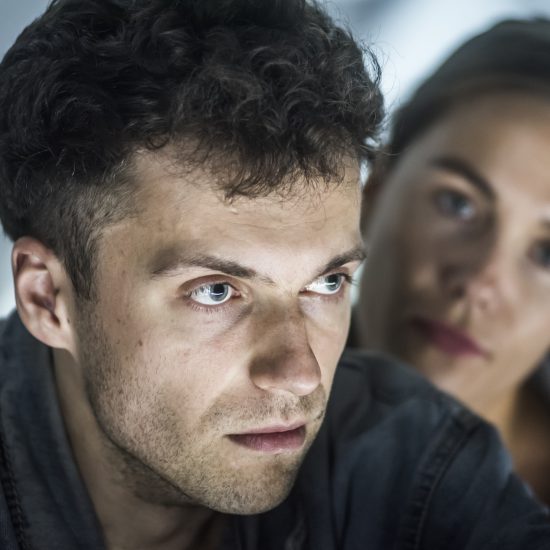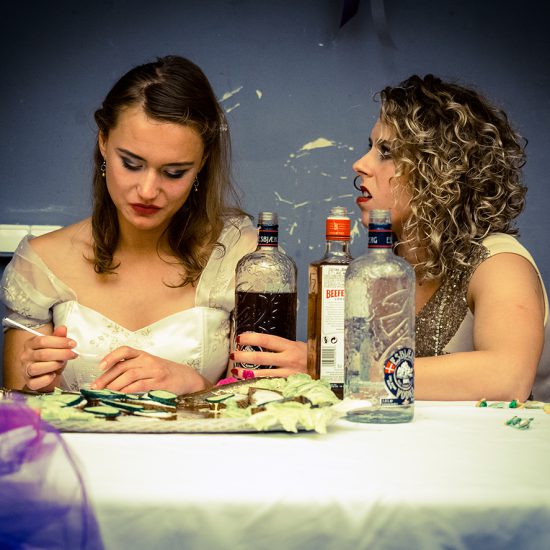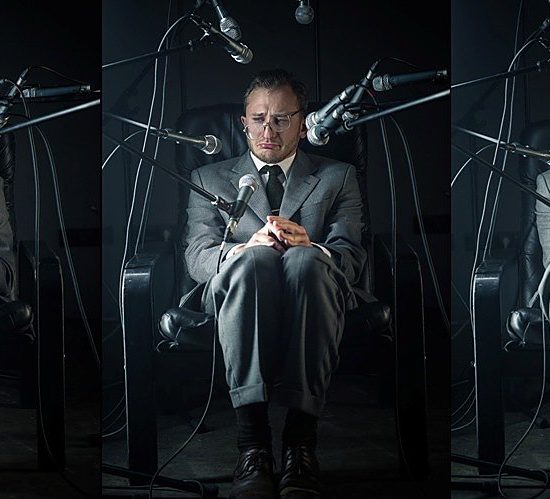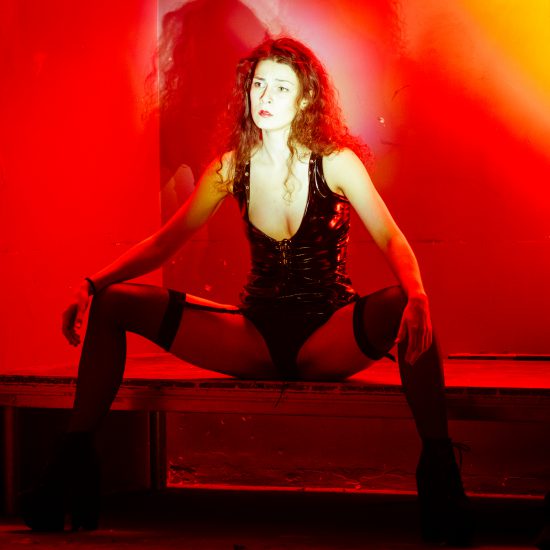Oskaras Koršunovas: tear down the walls for the sake of the theater of ruthless truth
In “Hamlet” we were invited to ask ourselves the question “Who are you?” Who are you as an actor, who you are as a character, who you are as a spectator? The question asked over and over again, sounding louder and louder, becomes the prologue of the tragedy by Shakespeare, taking us to the time before the beginning of the play, when the actor prepares for his role in the make-up room, that place of transformation and self-creation where an existence and a semblance merge and double. Along with the actors, we are also moved to an illusory space defined by the coulisses of moving mirrors, all of which remain on the stage during the performance. Symbolic and real, they multiply the bodies and faces and disclose conspiracies and frauds. It is enough to turn them around their axis for the guard towers of Elsinore or the luxurious walls of the palace to appear. There is a short flashback of the interiors seen in Branagh’s film, but here the script is created by the actors themselves who, in front of the eyes of the audience, change the positions of light sources in quick kaleidoscopic geometries. The author of the original set design is Koršunovas himself.
[…]
In “Hamlet” the metaphor of the mirror becomes even more complex. When I saw the performance for the first time at the Wroclaw Dialog Festival in 2009, I was moved by the extraordinary metatheatrical power of Koršunovas’ directing, and his ability not only to bring the theater within the theater into the spotlight, but also to create the theater within the theater. The make-up rooms do not belong to any separate backstage reality, but they are the actual place where tragedy occurs. Except that small space, the actors only have several other everyday items, such as a jar of paint, a pack of cigarettes, a glass of water, some flowers, and tissues to wipe off their make-up and re-discover their own faces, but then… everything transforms. The flowers become the curtain of Ophelia’s death, and the tissues gradually fill the entire stage – later, as the story becomes more and more bloody, they become red. A strident sound signals the start of the play and at once the actors merge into Shakespeare’s characters. The scenes of the play, separated by that same ominous sound, follow one another in a broken rhythm resembling a lament. These are the peaks of high voltage emotions, as if the actors suddenly become devoured by passion, inspiring life to their characters, but a short while later they are again sitting in front of the mirrors prepared to follow the instructions and enter the stage or make their exit. And so on until the end, when, accompanied by the drums of his army, Fortinbras arrives and roughly pulls out the lighting cables of the mirrors, thus deleting the actors’ faces and our faces.
[…]
This “Hamlet”, still admired by a wide audience, like in Pontedera two years ago, is a starting point not only for us. For Koršunovas it marks the beginning of a new study aimed of the mysterious nature of the art of theater and its meaning. Since then, the director has begun a new type of work with his amazing actors, encouraging them to participate in the creative process, starting from their own personal experiences. “Who are you?” is a question whose mechanism is started by their imagination, forcing them out of the cage of their roles’ fiction, teaching them to be themselves and the other at the same time. In “Hamlet” this problem expands and touches the audience, ripping off the mask of the invisible observer.
[…]
The Lower Depths
In “Hamlet” the frontal reflection in the mirrors separated us from the actors, but the sound signal activated the change of attention within us. In “The Lower Depths” the distance has shortened dramatically. The actors/Gorky’s characters have turned their faces to the audience and are looking at us from across the table loaded with glasses and vodka bottles. Now we are all illuminated and part of the same drinking spree where angry drunkenness and seemingly incoherent speech are trying to revive the lost memories and imagined love stories claiming a different identity than the one that belongs to the dire present. Drama lies precisely in the need to speak about their problems and to be heard. They turn to us in response to the taunts of their drinking companions, inviting us to drink, to share their concerns, to try to find an answer to the tormenting question “What is man?” when he is so desperately adrift like when the Baron does not know who he is, or when the Actor realizes that he has lost everything in the void of his memory.
[…]
The Seagull
In “The Seagull”, the latest part of the trilogy, there’s no long table, so there is no material barrier between us and the actors sitting with us. This coexistence sharpens up our senses, trains the eye and the ear. On the stage there are only rows of chairs lined up to face the audience, prepared for the audience of Kostya’s play. Masha’s lonely voice intonates the theme of lust and the impossibility of love, which becomes a prologue for the scene of the play-within-the-play where we are confronted with Arkadina’s emotional blindness, Trigorin’s distracted selfishness, Nina’s thirst for life, and Treplev’s desperate artistic searches. And namely the cruelty of this scene from the very onset determines the tonality of the whole staging by Koršunovas, and, needless to say, his actors are great at conveying the timid passion of young people and their defeat in the world that meets their talents with contempt or indifference, and only steals their youth. In a world that is so tragically similar to ours. At the end, when Nina leaves driven by a willful desire to live and be an actress, Treplev furiously tears up his manuscripts and the play ends in the vacuum of his single suicide backstage. Hamlet, Actor and Kostya are connected by a common fate of death, which, according to Koršunovas, “leaves no hope.” From the Greek theater the director’s tragic vision has borrowed the elements of horror, pity and catharsis in order to move them to our times. From this perspective, the viewers should find themselves in the role of the ancient chorus, yet it badly lacks a dramatic voice, while the applause is simply not enough.
****
Laura Caretti, HYSTRIO, 2014, Issue No. 1 (January to March)



